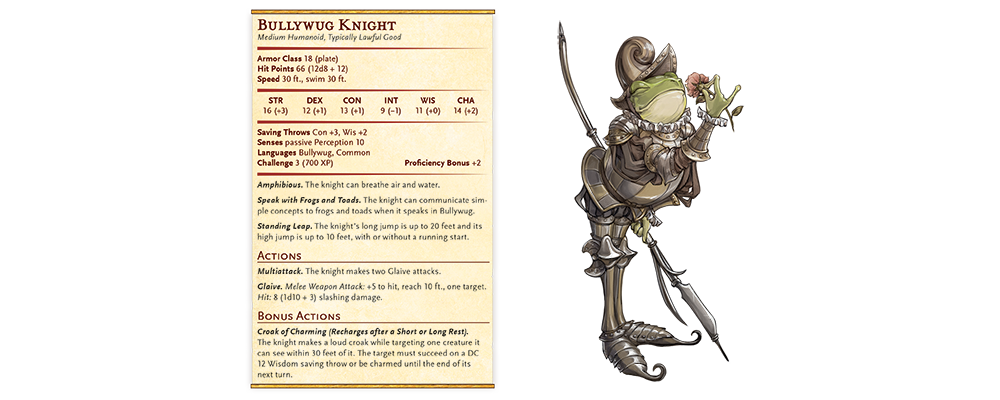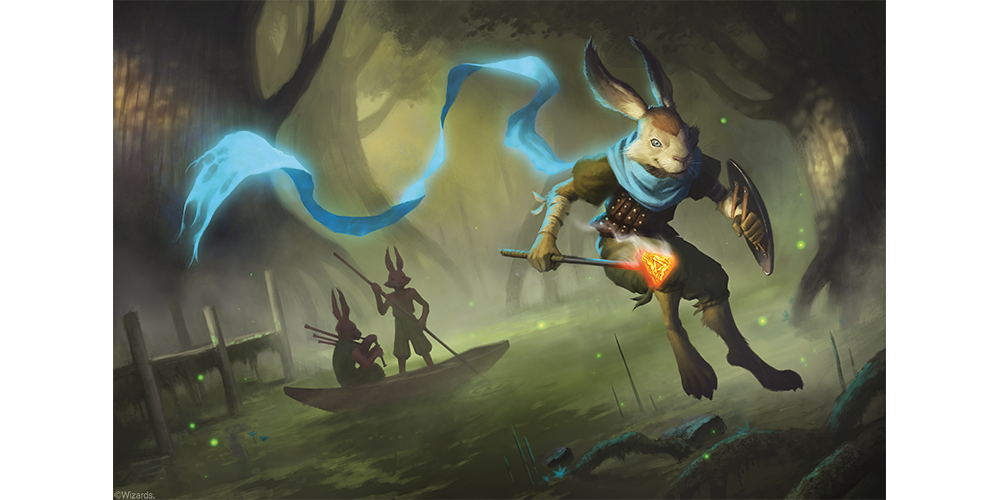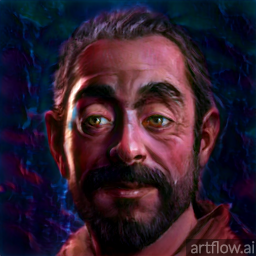STAT BLOCK REFINEMENTS
Over the past year or so, we’ve been refining the D&D stat block to make it easier to use and to improve how DM-controlled creatures function in play. The following sections describe the main changes we’ve made. You can find these changes in
The Wild Beyond the Witchlight, as well as in
Fizban’s Treasury of Dragons,
Strixhaven: A Curriculum of Chaos, and
Mordenkainen Presents: Monsters of the Multiverse.
 CREATURE TYPE
CREATURE TYPE
Creature types are now always capitalized. We’ve made this change so that it’s easier to tell in our rules when we’re talking about a monster of a certain type (a Giant, for example), rather than using a word in its normal sense (“She was a giant in the bard community”).
We’ve also gotten strict about which monsters get the Humanoid creature type. This type is now reserved for creatures who are humanlike in their moral and cultural range. As we update older books, we’ll reassign some Humanoids to other creature types. When
Monsters of the Multiverse is released, you’ll see that some former Humanoids are now Monstrosities, Fey, and other types.
ALIGNMENT
Alignment had a time out in the stat blocks of
Candlekeep Mysteries and
Van Richten’s Guide to Ravenloft. We omitted alignment in those books as a temporary measure, giving us time to determine how to handle alignment going forward. Now that we’ve done that work, alignment returns in
The Wild Beyond the Witchlight and appears in all our other upcoming books as well.
So why did alignment get a time out? For a while, there’d been some confusion in the community about alignment’s role in D&D. In the rules of the
Player’s Handbook, you choose your character’s alignment, and in the rules of the
Monster Manual, the DM determines a monster’s alignment. No matter what alignment is chosen, a creature’s alignment describes that creature’s moral outlook; alignment doesn’t determine the creature’s behavior. Alignment is essentially a roleplaying aid.
Both books are clear about the player and the DM having the final say on alignment, but both books also plant a seed of doubt. The
Player’s Handbook suggests alignments for various folk in the D&D multiverse, and the stat blocks in the
Monster Manual include alignments without reminding the DM that those alignments are merely suggestions.
To eliminate that seed of doubt while preserving alignment’s function as a roleplaying tool, we’ve made the following changes:
- Only named individuals, such as Mister Witch and Mister Light, have a definite alignment.
- Generic Humanoids bear the words “Any Alignment,” reminding the DM that such people have vast moral range.
- Magical creatures that have a strong moral inclination (angels, demons, devils, undead, and the like) have an alignment preceded by the word “Typically.” For example, a demon’s stat block says “Typically Chaotic Evil,” since it is typical for a D&D demon to be chaotic evil. That one word—“typically”—reminds the DM that the alignment is a narrative suggestion; it isn’t an existential absolute. The holy can fall, and the fiendish can rise. Members of certain organizations—charitable knighthoods or diabolical cults, for example—also sometimes get the “Typically” treatment.
- Creatures, such as most Beasts and Oozes, that are incapable of moral discernment continue to lack an alignment and therefore bear the term “Unaligned.”
TAGS
Occasionally a creature has a tag—Elf, Goblinoid, Titan, or the like—that identifies an important detail that doesn’t appear elsewhere in the stat block. We’ve begun introducing new tags, which some rules now reference, allowing us to create fresh ways for creatures to interact with the game’s system. For example, some creatures now include a tag that is the name of a spellcasting class, such as Cleric, Druid, or Wizard, and
Monsters of the Multiverse includes a rule that says such a tag means the creature counts as a member of the named class for the purpose of magic item attunement.
PROFICIENCY BONUS
Many of the numbers in a stat block include the creature’s proficiency bonus. Because of that fact, a creature’s proficiency bonus now appears in the stat block. The number sits to the right of the creature’s challenge rating.
BONUS ACTIONS
If a creature has any bonus actions, those actions now appear in a section called “Bonus Actions” in the stat block. That section goes after the “Actions” section, and if a monster has a “Reactions” section, the “Bonus Actions” section goes between “Actions” and “Reactions.”
This new section makes it easier for a DM to spot bonus actions when running a creature, which previously hid among a creature’s traits near the top of the stat block.
SPELLCASTING
Since 2014, spellcasting creatures have tended to have the Spellcasting trait, the Innate Spellcasting Trait, or both. Starting in 2021, we have merged those two traits into an action called Spellcasting. That action now appears in the “Actions” section of a stat block, and it has a few important qualities:
- The Spellcasting action doesn’t use spell slots. A creature can cast the action’s spells a certain number of times per day.
- The only spells that appear in the Spellcasting action are ones that take an action to cast. If a spell requires a bonus action, a reaction, or a minute or more to cast, that spell must appear elsewhere in the stat block. This change ensures that bonus actions and reactions—such as misty step and shield—aren’t hiding out in a list of spells.
- We’re more selective about which spells appear in a stat block, focusing on spells that have noncombat utility. A magic-using monster’s most potent firepower is now usually represented by a special magical action, rather than relying on spells.
NEW CHARACTER RACES
The new character races in
The Wild Beyond the Witchlight—the fairy and the harengon—both appeared in
Unearthed Arcana, and they now appear in their final form in that book. The races have several characteristics that you’ll see not only in the book, but also in the character races in our other upcoming books. These characteristics are explored below.
CREATURE TYPE
In the past, a character race was presumed to have the Humanoid creature type. In the new races, the character’s creature type is specified. For example, the fairy has the Fey creature type.
Creature types don’t have rules themselves, but some rules in the game affect creatures of certain types in different ways. For example, the
cure wounds spell doesn’t work on a Construct or an Undead.
ABILITY SCORE INCREASES
New character races don’t have the Ability Score Increase trait that
Player’s Handbook races have. The new races instead rely on a special character-creation rule that allows a character to increase one ability score by 2 and another score by 1 or to increase three different ability scores by 1. The lack of the Ability Score Increase trait helps make your choice of race and your choice of class independent from each other, broadening the types of characters we’re likely to see at the game table.
If you’re having trouble deciding which scores to increase, we recommend consulting your class’s “Quick Build” section. For example, the bard’s “Quick Build” section recommends you increase your character’s Charisma and Dexterity.
AGE
New character races lack an Age trait. We instead now provide the following text about a character’s life span: “The typical life span of a player character in the D&D multiverse is about a century, assuming the character doesn’t meet a violent end on an adventure. Members of some races, such as dwarves and elves, can live for centuries.”
ALIGNMENT
Previously, the text of a character race suggested an alignment for your character. Newer races contain no such alignment suggestions, since a character’s alignment is entirely under the purview of the player.
SIZE
Some new races, including the harengon, let you choose whether your character starts Medium or Small, reflecting the fact that some races contain an especially broad range of builds. You’ll see this choice in other races in the future.
Also, rather than suggesting height and weight in a race, we provide the following text: “Player characters, regardless of race, typically fall into the same ranges of height and weight that humans have in our world. If you’d like to determine your character’s height or weight randomly, consult the Random Height and Weight table in the
Player’s Handbook, and choose the row in the table that best represents the build you imagine for your character.”
LANGUAGES
The new races lack traits that are purely cultural, so they don’t include a Languages trait. Instead, new characters start knowing Common and one other language that you and your DM agree is appropriate for your character.
RABBIT HOP QUESTIONS
When a harengon uses Rabbit Hop, does the trait’s jump expend movement? The Rabbit Hop trait lets a harengon jump as a bonus action, and that jump doesn’t consume any of the harengon’s normal movement. That fact is why the trait has a limited number of uses between long rests. If you compare the wording of Rabbit Hop to the wording of the long and high jump rules in the
Player’s Handbook, you’ll see that those rules explicitly expend movement, whereas Rabbit Hop doesn’t.
Is Rabbit Hop a high jump or a long jump? The jump of Rabbit Hop is neither a high jump nor a long jump. If it were either, its text would say so.
Does the jump spell benefit Rabbit Hop? Yes, the jump spell can affect the jump distance of Rabbit Hop. If you cast that spell on a harengon, enjoy the magnificent leaps!
Are you required to jump the full distance of Rabbit Hop? You don’t have to jump the full distance of Rabbit Hop when you use it. We will clarify that intent in future printings of the Rabbit Hop trait.

















![Glory to Codexia! [2012] Codex 2012](/forums/smiles/campaign_tags/campaign_slushfund2012.png)






